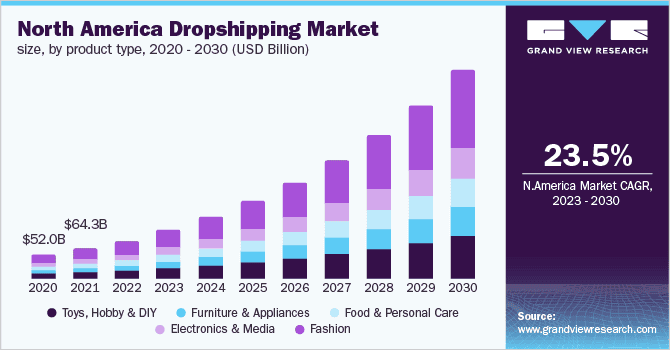
In the dynamic world of online retail, navigating the path to success can be daunting. As we enter 2024, the challenges and opportunities in e-commerce continue to shape how entrepreneurs approach their ventures. If you’re seeking a business with flexibility, minimal upfront investment, and significant potential profits, dropshipping is a compelling option. But what is the best way to dropship in 2024?
This article will delve into the intricacies of dropshipping, exploring why it’s a viable choice for aspiring entrepreneurs. We understand the pain points eCommerce beginners face – inventory management, upfront costs, and logistical challenges. Fear not! We will address these concerns and provide a comprehensive guide on the best way to dropship in 2024. From establishing your budget to navigating potential pitfalls, consider this your roadmap to dropshipping success in the coming year.
What Is Dropshipping?
Dropshipping is a business model that allows you to sell products without dealing with inventory, packaging, or shipping. Instead of purchasing and storing products upfront, you partner with a supplier who handles the inventory and shipping processes.
As a dropshipper, your main focus is on the front end of the business – building an enticing online store, selecting winning products, and reaching your target audience. When a shopper orders from your store, the supplier ships the product directly to your customer. Thus, you do not need to manage a warehouse or worry about shipping logistics.
In essence, dropshipping allows you to concentrate on connecting with customers and growing your business while leaving the inventory management to your suppliers. It’s a seamless and efficient way to enter e-commerce without the traditional headaches that come with it.
Why You Should Start Dropshipping in 2024
Embarking on dropshipping in 2024 holds immense potential for success. Firstly, consider the thriving global dropshipping market, boasting a staggering value of $226B in 2022. Furthermore, projections indicate a robust compound annual growth rate of 23.4% from 2023 to 2030, promising sustained expansion.

The landscape is ripe for entrepreneurs as the market witnesses significant growth. This growth is fueled by the escalating preference for online shopping, which is a trend that shows no signs of slowing down. Furthermore, the rising wave of cross-border e-commerce trade adds another layer of opportunity for prospective dropshippers.
Starting a dropship journey in 2024 isn’t just a business move; it’s a strategic leap into a realm of remarkable profit potential. Let’s explore why this model is set to shine in the upcoming year:
1. Low Startup Costs
Unlike traditional retail models that demand significant upfront investments, you can kickstart your dropship business with minimal financial strain. This means less risk and more room for experimentation and growth.
2. Work Anywhere, Anytime
Imagine a business that fits your lifestyle, not the other way around. With dropshipping, geographical constraints become a thing of the past. The flexibility to work from anywhere, anytime, opens up a world of possibilities. Therefore, the dropship model is an ideal choice for the digital nomad or anyone seeking work-life balance.
3. Pay Only After Getting Paid
One of the most enticing aspects of dropshipping is the “pay-as-you-go” nature. You only pay for products when a customer makes a purchase, eliminating the need for extensive upfront investments. This financial model aligns with the rhythm of your sales, ensuring a healthy cash flow.
4. No Physical Inventory Required
Bid farewell to the logistical nightmare of managing physical inventory. In dropshipping, your role is to curate a compelling online storefront and leave the storage and shipping hassles to your trusted suppliers. It’s a lean, efficient, and cost-effective approach.
5. Easy to Replace Products That Don’t Sell
In the fast-paced world of e-commerce, trends can shift rapidly. When dropshipping, adapting to changing market demands is a breeze. You can swap out products that aren’t selling without risking ending with unsold inventory.
6. Highly Scalable
The scalability of dropshipping is also a game-changer. As your business grows, there’s no need to worry about expanding warehouse space or logistics. Because your suppliers handle the infrastructure, you can focus on scaling up your marketing efforts and customer base.
7. Low Entry Barrier
The low entry barrier of dropshipping means that aspiring entrepreneurs from all walks of life can enter the market with relative ease. Whether you’re a seasoned business professional or a newcomer, the doors are wide open.
In summary, the allure of dropshipping in 2024 lies not only in its profit potential but also in the transformative way it aligns with the preferences and needs of today’s entrepreneurs. It’s a business model designed for the future – a future where flexibility, efficiency, and profitability seamlessly converge.
Best Way To Dropship In 2024 – Full Guide

Embarking on your dropshipping journey is an exciting venture, but doing it right is paramount for long-term success. Let’s break down the essential steps for the best way to dropship.
1. Determine Your Starting Budget
Starting a dropshipping business is often lauded for its low entry barriers, but that doesn’t mean you can overlook the financial aspects. To begin, consider the following factors:
Firstly, it’s essential to identify the initial costs associated with setting up your dropshipping store. These include platform fees, domain registration, and initial marketing investments. Keep in mind that while the dropship model minimizes traditional inventory costs, there are still operational expenses to consider.
Secondly, different platforms come with varying fee structures. Whether you choose eBay, Shopify, Amazon, or another platform, be aware of monthly subscription fees, transaction charges, and any additional costs associated with using the platform’s features. Factor these into your budget to ensure a clear financial picture. Use tools like this eBay fees calculator to calculate your profits accurately, so you’ll know exactly how much you’re spending and profit.
Effective marketing is the lifeblood of a successful e-commerce business. Therefore, allocate a portion of your budget to marketing efforts, like social media ads, influencer collaborations, or search engine optimization (SEO). A well-thought-out marketing strategy is an investment in your store’s visibility and success.
While keeping an eye on expenses, understanding the potential for earnings is equally crucial. Research product niches and estimated profit margins to gauge the revenue you can generate. Consider the time it may take for your store to become profitable and factor this into your budgetary planning.
Build flexibility into your budget for unexpected expenses or opportunities. The e-commerce landscape is dynamic; having room to adapt to changes or seize a promising opportunity can be a game-changer. Flexibility in your budget ensures you can navigate unforeseen challenges without derailing your progress.
2. Conduct Product Research
In the realm of dropshipping, success hinges on finding products that resonate with your target audience. Conducting thorough product research is not just a step; it’s the guideline towards the right products and profitable niches. Let’s explore how to navigate this pivotal phase effectively.
Firstly, identify market trends. Start by delving into current market trends. Analyze what’s gaining traction and understand consumer preferences. Tools like Google Trends can provide insights into the popularity of potential products over time. This initial step sets the foundation for a product lineup that aligns with the pulse of the market.
Furthermore, assess demand and competition. Beyond trends, delve into the demand for prospective products and evaluate the level of competition. Tools such as Amazon’s Best Sellers and eBay’s Trending Products can offer valuable data. Striking a balance between demand and competition ensures you’re entering a market with profit potential while avoiding saturation.
Additionally, consider profit margins. While passion for your products is essential, it’s equally crucial to consider profit margins. Identify products with a healthy balance between demand and profitability. Don’t just focus on high-demand items; assess the potential for reasonable profit margins to ensure a sustainable and lucrative business model.
Finally, validate with test products. Before committing to a full product lineup, consider testing a few products. This allows you to gauge customer response, test marketing strategies, and make informed decisions about expanding your product offerings. It’s a practical way to validate your research before making substantial investments.
Conducting comprehensive product research isn’t just a box to check; it’s a dynamic process that shapes the trajectory of your dropship business. By staying attuned to market trends, demand, competition, and profitability, you position yourself to curate a winning product lineup that resonates with your audience and propels your venture toward success.
3. Select A Reliable Dropshipping Supplier
Choosing the right dropshipping supplier is akin to selecting a reliable partner for your business journey. Suppliers play a pivotal role in the customer experience and the overall success of your venture. Let’s explore the essential steps in selecting a supplier with confidence.
Firstly, assess reliability. It is the cornerstone of a trustworthy supplier. Research potential suppliers thoroughly, examining their track record in terms of order fulfillment, product quality, and shipping times. Customer reviews and testimonials can provide valuable insights into the supplier’s performance.
Furthermore, evaluate product quality. While the allure of a vast product catalog is enticing, prioritize quality over quantity. Request samples or order a few products to assess their quality firsthand. High-quality products not only satisfy customers but also contribute to positive reviews and repeat business.
Additionally, consider shipping times, as they can significantly impact customer satisfaction. Choose a supplier with reasonable and consistent shipping times. This not only enhances the customer experience but also reduces the likelihood of negative feedback related to delays.
Moreover, check communication channels. Effective communication with your supplier is essential for a smooth operation. Ensure that your supplier is responsive and offers clear communication channels. Timely updates on inventory, shipping, and any potential issues contribute to a transparent and collaborative partnership.
Lastly, verify policies and fees. Before finalizing your partnership, delve into the supplier’s policies and fee structures. Understand any upfront or ongoing fees, as well as return and refund policies. Clarity on these aspects ensures a transparent and mutually beneficial relationship.
4. Choose A Dropship Platform
Selecting the right platform for your dropshipping business is like choosing the perfect stage for your performance. The platform you opt for shapes the user experience and influences your store’s functionality, visibility, and overall success. Here is what you should consider for the best way to dropship.
Firstly, consider your business needs, as it is the first step in choosing an ideal platform. Different platforms offer varying features and capabilities. Evaluate whether you need extensive customization options, a user-friendly interface, or specific e-commerce tools to align with your business goals.
Furthermore, explore popular eCommerce platforms. Several platforms cater to dropshippers, each with its unique strengths:
- Shopify, known for its user-friendly interface, suits beginners.
- Amazon and eBay provide access to a massive customer base.
- Etsy appeals to those focusing on handmade or unique products.
- Facebook and Wix offer diverse options for online storefronts.
Additionally, assess user-friendliness. A user-friendly platform is essential, especially if you’re just starting. Shopify, for example, boasts a straightforward setup and intuitive design, making it accessible for newcomers. Consider the learning curve of each platform and choose one that aligns with your technical comfort and expertise.
Moreover, factor in costs. Platform fees can vary, impacting your overall budget. Assess the fee structures of potential platforms, considering transaction fees, monthly subscriptions, and any additional costs associated with using specific features. Striking a balance between functionality and affordability is key.
Lastly, think about long-term scalability. Your chosen platform should not only meet your current needs but also support future growth. Consider the scalability of the platform – can it accommodate a growing product catalog, increased traffic, and evolving business requirements? A platform that grows with your business ensures a seamless and sustainable journey.
5. Import Winning Products To Your Dropshipping Store
Now that we’ve identified items to sell and partnered with reliable suppliers, it is time to list our products. Effectively showcasing and managing your product lineup is the best way to dropship.
We should start by integrating our products seamlessly into our eCommerce platform. Leverage the features offered by your chosen platform – be it Shopify, Amazon, Etsy, or others – in order to ensure a user-friendly and visually appealing presentation. Consistency in branding and product placement enhances the overall shopping experience.
Take advantage of dropshipping automation tools like AutoDS’ Product Importer to reduce manual tasks and instantly list items.
Furthermore, we must optimize product titles and descriptions. Craft compelling and informative text. Highlight key features, benefits, and any unique selling points. Clear, engaging descriptions aid in conversion and contribute to a positive customer experience. Transparency builds trust, a cornerstone in the world of e-commerce.
Invest in high-quality imagery for your product listings. Visual appeal is a powerful tool in online retail. Provide multiple pictures showcasing different angles and details of the product. High-resolution photos create a sense of professionalism and authenticity, enticing potential customers to explore further.
Moreover, an effective categorization is a must. Organize your product catalog with effective categorization. Ensure that your customers can easily navigate through different product categories, finding what they need with minimal effort. A well-structured store enhances user experience and encourages prolonged exploration.
Lastly, constantly monitor and update inventory and availability. Implement dropshipping automation to update product availability in real-time, preventing overselling and potential disappointments. Clearly communicate stock levels to manage customer expectations and ensure a smooth order fulfillment process.
6. Set & Run Online Marketing Campaigns

With your winning products listed, the spotlight now turns to attracting customers. Setting up and executing effective online marketing campaigns is the fuel that propels your dropshipping venture to new heights. Let’s dive into the essential steps to make your products shine in the vast digital landscape.
Firstly, we must define our target audience. Precision is key in online marketing. Thus, we can learn our target audience based on demographics, interests, and online behavior. Understanding who your ideal customers are lays the foundation for crafting messages that resonate and campaigns that convert.
Furthermore, you should take advantage of social media platforms. Social media platforms are dynamic hubs for connecting with potential customers. Leverage the power of social commerce platforms like Facebook, Instagram, and Twitter to showcase your products. Engage with your audience through visually appealing content, promotions, and interactive posts.
Then, you can complement your organic reach with paid advertising. Platforms like Facebook Ads and Google Ads offer targeted advertising options. Allocate a portion of your budget to strategic ad campaigns, ensuring your products are prominently featured to users likely to convert.
Moreover, consider leveraging influencer collaborations. Influencers wield significant influence (pun intended) in the online realm. Utilize influencer marketing platforms to find influencers whose audience aligns with your target market. Their endorsement can introduce your products to a broader audience and build credibility for your brand.
Finally, monitoring and optimizing campaign performance is vital for the best way to dropship in 2024. Launching campaigns is just the beginning. Regularly monitor the performance of your marketing efforts. Analyze metrics such as click-through rates, conversion rates, and return on ad spend. Use these insights to refine your strategies and optimize for maximum impact.
7. Order Fulfillment
Now that your marketing efforts have beckoned customers to your e-store, you should start getting orders. This leads us to the next step of the best way to dropship – order fulfillment. While not the most exciting, this phase is crucial – it bridges a successful sale and a delighted customer. Let’s consider what ensures a seamless and gratifying order fulfillment process.
The preparations begin even before we start receiving orders. We must establish clear lines of communication with our dropshipping suppliers. Timely and transparent communication ensures that they are aware of new orders promptly. This collaboration is the backbone of a reliable and efficient order fulfillment process.
Furthermore, implement order tracking to enhance the customer experience. Provide customers with the ability to monitor the status of their orders in real-time. This keeps them informed and adds a layer of transparency and trust to your brand.
If possible, optimize packaging and shipping times. Efficient packaging and swift shipping contribute to customer satisfaction. Collaborate with suppliers to optimize packaging for protection and aesthetics. Additionally, work towards reducing shipping times by choosing fast suppliers to ensure customers receive their orders promptly.
You can further enhance order fulfillment with services like Fulfilled by AutoDS. It streamlines dropshipping operations with order automation, processes orders through AutoDS accounts with unlimited credit, and simplifies returns with one-click functionality.
8. Provide Excellent Customer Support
As the heartbeat of any successful dropship venture, customer support is the bedrock upon which you build customer satisfaction and brand loyalty. Ensuring an excellent customer support experience is not just a service – it’s a commitment to fostering lasting relationships.
Firstly, establish clear communication channels, which are the foundation of exceptional customer support. Clearly showcase multiple communication channels like email, live chat, and a dedicated customer support portal. Accessibility empowers customers to reach out with ease.
Furthermore, speed is of the essence in customer support. Respond promptly to customer inquiries, acknowledging their concerns professionally. Swift responses not only address issues efficiently but also convey a sense of attentiveness and care.
Additionally, anticipate and solve problems proactively. Implement informative FAQs, guides, and troubleshooting resources on your website. A proactive approach minimizes the need for reactive problem-solving and empowers customers to find solutions independently.
Moreover, personalize customer interactions. Address customers by name, tailor responses to their specific queries, and express genuine empathy. Personalization creates a connection, transforming routine interactions into memorable experiences.
Lastly, gather and act on customer feedback, a goldmine for improvement. Actively seek feedback through surveys, reviews, and post-purchase communication. Use this valuable information to continually identify areas for enhancement and refine your customer support strategy.
9. Automate Your Dropshipping Business
The best way to dropship in 2024 is impossible without dropshipping automation. While effective marketing strategies amplify visibility, the true catalyst for sustainable growth lies in using automation. Why? Let’s find out!
Firstly, it provides price and stock monitoring. Automation tools such as AutoDS offer real-time tracking to monitor product prices and availability effortlessly. It saves time, ensures your store is up-to-date, and remains competitive in the ever-evolving market.
Furthermore, order fulfillment is a breeze with automation. It can streamline the entire process, from order placement to shipping. This reduces manual intervention and minimizes the risk of errors, ensuring a smooth and reliable fulfillment pipeline.
Automation tools also simplify product importing. You can effortlessly add new and trending items to your catalog. This not only keeps your inventory fresh but also ensures that your store stays aligned with market demands without the need for manual input.
Pricing optimization is another critical aspect of dropshipping success. Automation tools can analyze market trends and adjust prices dynamically, maximizing your profit margins. This strategic pricing approach ensures competitiveness and profitability without constant manual recalibration.
Lastly, dropshipping automation enhances overall business management. Automation extends beyond specific tasks, offering comprehensive solutions for image and product editing, business policy templates, and easy inventory management. These features collectively contribute to efficient business operations, freeing up your time for strategic planning and growth initiatives.
In summary, by automating price and stock monitoring, order fulfillment, product imports, price optimization, and overall business management, you empower your venture to thrive and expand effortlessly.
10. Run & Manage Your Business
Successfully running and managing a dropshipping business involves a delicate orchestration of various elements. From strategic decision-making to day-to-day operations, each aspect contributes to the overall health and growth of your venture. So, let’s explore the key components of running and managing your dropshipping business in the best way.
Keep a finger on the pulse of your business by regularly analyzing performance metrics. From sales data to website analytics, understanding the trends and patterns allows you to make informed decisions. Platforms like Google Analytics and sales dashboards can be invaluable in this regard.
Furthermore, stay informed about market trends. The e-commerce landscape is dynamic, with trends evolving rapidly. Being proactive in adapting to these changes ensures that your business remains relevant and competitive.
Additionally, embrace continuous learning. Stay abreast of industry updates, marketing trends, and technological advancements. This commitment to learning positions you as a dynamic and informed entrepreneur, ready to navigate the challenges and opportunities that arise.
Moreover, keep fostering customer relationships, a cornerstone of business success. Engage with your audience through social media, email marketing, and personalized communications. Customer feedback and loyalty are not just indicators of satisfaction but also powerful catalysts for positive word-of-mouth marketing.
Finally, delegate and prioritize tasks. Effective delegation is crucial in managing the various aspects of your business and overcoming common dropshipping challenges. Identify tasks that can be automated or outsourced, allowing you to focus on high-priority activities. This strategic approach ensures that you invest time and energy where they matter most.
Dropshipping Products You Need To Avoid

We must steer clear of certain product categories for the best way to dropship. It is not just a matter of preference but a strategic decision for the longevity and legality of our business. Let’s explore the categories of products that warrant caution and are best to avoid.
Dangerous Goods
Firstly, and perhaps most importantly, avoid dealing with dangerous goods. Products that pose a risk to safety, health, or the environment can lead to legal complications and reputational damage. It’s crucial to prioritize the well-being of your customers and adhere to safety regulations.
Medicine Or Supplements
Delving into the realm of pharmaceuticals, medicines, or supplements is a minefield of regulations and potential health risks. Dropshipping these products can lead to legal liabilities and compromise customer safety. So it is best to leave the health and wellness sphere to licensed professionals and established retailers.
Copyrighted Items
Selling copyrighted items without proper authorization is a sure recipe for legal troubles. It’s not just about respecting intellectual property rights but also avoiding potential lawsuits. Always ensure that the products you’re dropshipping do not infringe on copyrights, trademarks, or patents.
Age-Restricted Products
Products with age restrictions, such as tobacco, alcohol, or adult content, should be handled with extreme caution. Compliance with age verification regulations is complex and varies by region. Navigating these restrictions without proper protocols can lead to legal repercussions and damage your business reputation.
Adhere to these guidelines in order to create a solid foundation for a dropshipping business that not only thrives but does so within the bounds of legal and ethical standards.
Frequently Asked Questions
What Is the Best Way To Dropship?
The best way to dropship is by starting with a clear budget, conducting thorough product research, selecting reliable suppliers, choosing a suitable selling channel, and using automation tools.
What Are The Different Dropshipping Fees?
Dropshipping fees typically include platform fees (e.g., Shopify subscription), transaction fees, and potential marketing expenses. Supplier costs and shipping fees are also factors to consider. The fees depend on the chosen platform, supplier agreements, and marketing strategy.
What Is The Best Platform To Start Dropshipping?
The best platform to start dropshipping depends on your business needs. Shopify is user-friendly, Amazon offers a vast customer base, and Etsy is ideal for unique products. Choose based on your target audience, product type, and desired features.
Do I Have To Pay Taxes When Dropshipping?
Yes, taxes are applicable when dropshipping. You are responsible for income taxes on your profits, and sales tax may apply depending on your location and the customer’s location. Therefore, you should consult with a tax professional to ensure compliance with relevant tax regulations.
Conclusion
In conclusion, embarking on the dropshipping journey is not just a venture; it’s a strategic commitment. The best way to dropship in 2024 requires a clear budget, thorough product research, reliable suppliers, and a well-chosen platform. This initial groundwork is vital for long-term success.
It’s not just about dropshipping; it’s about dropshipping correctly. This deliberate approach, coupled with effective marketing, streamlined operations, and customer-centricity, paves the way for a thriving venture. In dropshipping, the right start is the compass that guides you toward sustained success.
For the best start, we recommend you check out the following guides:

